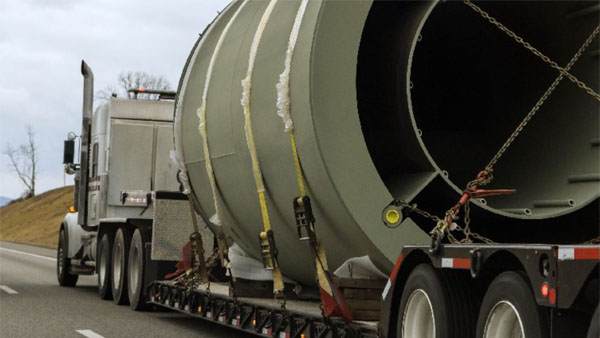Heavy Haul Transportation Supports Brevard’s Economy
By Space Coast Daily // October 24, 2025

Specialized transport, the planning, permitting, and movement of cargo that exceeds standard legal dimensions, has become a hidden engine of prosperity for the county’s aerospace, maritime, defense, and construction sectors.
This article looks under the hood at this critical industry, quantifies its impact, and shows why enabling these “big moves” today positions Brevard for even bigger growth tomorrow.
Key Industries That Depend on Heavy-Haul Logistics
Brevard County’s economy is uniquely shaped by industries that demand the movement of extraordinarily large, heavy, and high-value cargo. From rocket boosters destined for launch pads to wind turbine components bound for offshore installations, the region serves as a critical logistics corridor for sectors where standard freight simply won’t suffice.
Understanding which industries drive this specialized demand reveals why heavy-haul expertise isn’t just helpful. Below are the key sectors that rely on Brevard’s heavy-haul infrastructure and capabilities:
Aerospace & Space Launch
The burgeoning private and public space industry is a primary driver. SpaceX, the dominant launch operator at Cape Canaveral, regularly transports recovered first-stage boosters and clamshell fairings along Brevard roads to processing facilities at Cape Canaveral Space Force Station and Kennedy Space Center..
Maritime & Super-yacht Modules
Port Canaveral’s strategic investments are paying off. The port’s 2023 annual report indicates its new project-cargo berth handled a huge number of massive yacht sections and liquefied natural gas (LNG) fuel tanks last fiscal year, cementing its role as a key maritime hub.
Defense Manufacturing
National security relies on complex supply chains. The Florida Department of Transportation Permit Office regularly issues oversize permits for Department of Defense components destined for Cape Canaveral Space Force Station, highlighting the region’s defense significance.
Construction & Mega-Projects
Local infrastructure growth is built on heavy haulage. The recent SR-520 causeway rebuild, for instance, required the precise delivery of massive prefabricated bridge segments, each moved exclusively during overnight windows over an extended construction period.
Renewable Energy Components
Brevard is becoming a vital staging ground for clean energy. Major wind energy projects have leveraged Port Canaveral’s infrastructure to stage massive turbine blades and nacelles for deployment across the region.
Brevard’s Specialized-Transport Infrastructure & Modal Assets

Brevard County’s unique position as both a deep-water port hub and a gateway to America’s premier space facilities has driven decades of investment in transportation infrastructure purpose-built for oversized, overweight, and mission-critical cargo.
This isn’t standard logistics; it’s a tightly integrated network of cranes, rails, roads, and runways engineered to move payloads that would overwhelm conventional supply chains. Understanding each modal asset and how they interconnect reveals why Brevard remains the go-to corridor for aerospace, energy, and defense logistics on the East Coast.
Port Canaveral Heavy-Lift Capabilities
The port features deep-draft berths, powerful mobile harbor cranes, and dedicated project-cargo lanes. This infrastructure enables the efficient single-lift unloading of oversized components like rocket stages and wind-turbine hubs.
Road & Bridge Network
Key arteries such as SR-528, SR-520, and I-95 connectors are designed with substantial vertical clearances and reinforced shoulders to accommodate heavy multi-axle trailers. Designated escort corridors and a policy of scheduling the majority of annual moves in overnight windows help minimize public impact.
Florida East Coast Railway Heavy-Axle Spurs
The port-side rail system can accommodate heavy railcars, creating a direct link to Northrop Grumman’s Melbourne campus and regional steel fabricators, enabling seamless multimodal transport.
Airports & Spaceport Interfaces
The port-side rail system handles heavy-duty freight cars, creating a direct link to Northrop Grumman’s Melbourne campus and regional steel fabricators, enabling seamless multimodal transport.
Regional carriers, ranging from family fleets to global providers, anchor the ecosystem. Among them, experienced heavy haul trucking logistics teams routinely supply multi-state route engineering and specialized trailers that complement port and spaceport assets, ensuring seamless first- and last-mile moves.
Economic Impact & Job Creation
The economic benefits of specialized transport are substantial and widespread. The industry directly employs a significant workforce of licensed heavy-haul drivers, crane operators, certified riggers, and pilot-car contractors throughout the region.
Furthermore, indirect job creation extends into supporting sectors like fabrication shops, tire suppliers, and hospitality, multiplying the employment impact. Port Canaveral handles substantial volumes of project cargo annually, contributing millions in regional economic value, while oversize permitting fees generate considerable revenue for transportation infrastructure management.
Challenges, Regulations & Forward-Looking Solutions
Despite its successes, Brevard’s specialized-transport ecosystem faces a constellation of operational, regulatory, and infrastructure challenges that threaten to constrain growth as aerospace and energy demand accelerates. Restrictive night-only travel windows, designed to minimize public disruption, create tight scheduling constraints that limit driver availability and compress project timelines.
A statewide shortage of certified escort-car operators has become a critical bottleneck, adding weeks to permit approvals and forcing carriers to import escorts from neighboring states at premium rates.
Infrastructure aging compounds these issues. A significant portion of Brevard’s bridges carry weight restrictions that force heavy-haul convoys onto circuitous detours, adding fuel costs, wear on equipment, and unpredictable delays. The SR-401 bridge remains a persistent choke point for oversize loads.
Recognizing these vulnerabilities, state and county agencies have begun implementing forward-looking solutions. A substantial infrastructure investment will reinforce and widen shoulders along SR-528, the primary corridor between I-95 and the port, enabling safer and faster heavy-haul movements. Federal BUILD and INFRA grants are being pursued to replace the SR-401 bridge with a modern span engineered to handle much heavier gross vehicle weights.
Meanwhile, FDOT is piloting digital permitting platforms and real-time bridge-sensor networks to streamline approvals and dynamically reroute loads around temporary closures. These investments signal a commitment to maintaining Brevard’s competitive edge as the nation’s premier corridor for mission-critical cargo.
Moving Brevard Into the Future
Artemis launch infrastructure, commercial lunar payloads, and the emergence of offshore wind staging in the Atlantic all point to one conclusion: even larger, heavier, and more complex cargo is coming.
Brevard’s advantage lies in tackling bottlenecks before they appear by funding corridor upgrades, nurturing talent pipelines at local colleges, and fostering innovation partnerships. When Brevard moves big things efficiently, big things happen for Brevard’s economy.












